Embodiment, Autoethnography, Performance Poetry: Living with Severe Traumatic Brain Injury
Incarnation, autoethnographie, poésie performance : Vivre avec un traumatisme crânien grave
Douglas E. Kidd
M.L.S., University of Toledo
CPST/TBS, Harbor Behavioral Health, Toledo, Ohio
Founder, Undistracted Driving Advocacy, Partner, National Safety Council
Leader, Greater Toledo Brain Injury Support Group, Sylvania, Ohio
Member, Board of Trustees, Disability Rights Ohio, Columbus, Ohio
dkidd [at] rockets [dot] utoledo [dot] edu
Abstract
This presentation offers neurodivergence embodied, autoethnography, and performance poetry. The confluence of acquiring severe traumatic brain injury combined with exposure to concepts and paradigms while pursuing a graduate degree in Disability Studies, catalyzed emergence and triggered development of my disabled identity. The brain damage acquired causes issues of decoding/deciphering/processing, which in turn triggers and/or produces episodes of temporal dissonance. When these shifts in timing occur, they have tremendous impact on rational thought processes and emotional stability. The salient aspects of my new life – emotional sensitivity and volatility – may on the surface seem detrimental and undesirable; however, I celebrate these qualities as they greatly enhance my identification with and empathy for others, which in turn drive my artistic, social, cultural, political expression, quest for community and belonging. While temporal dissonance is unlikely to occur during this planned short presentation, I will relate and provide the audience with windows on largely hidden and little understood forms of impairment.
Note: To hear recitation of some of these poems, check out fellow VIBE presenter Cheryl Green’s podcast: http://whoamitostopit.com/pigeonhole-podcast-17-autoethnographic-poetry/
The original presentation at VIBE was accompanied by music from Miles Davis and Marcus Miller’s 1987 album Music from Siesta. Readers are encouraged to listen to this album via their music platform of choice while reading the following poetry. Youtube link to the album: https://www.youtube.com/watch?v=ZuvtNL_jyeQ
Résume
Cette représentation réunit une incarnation de la neurodivergence, l’autoethnographie et la poésie performance. La convergence de l’acquisition d’un traumatisme crânien grave et de l’exposition à des concepts et à des paradigmes tout en poursuivant un diplôme d’études supérieures en études sur le handicap a catalysé l’émergence de mon identité de personne handicapée et déclenché son développement. L’acquisition de lésions cérébrales provoque des enjeux de décodage/déchiffrement/traitement, qui à leur tour déclenchent et/ou produisent des épisodes de dissonance temporelle. Lorsque ces changements temporels se produisent, leur impact sur les processus de pensée rationnelle et sur la stabilité émotionnelle est énorme. Les aspects proéminents de ma nouvelle vie (sensibilité émotionnelle et volatilité) peuvent sembler négatifs et indésirables en surface. Cependant, je célèbre ces qualités, car elles améliorent considérablement ma capacité à m’identifier aux autres et mon empathie pour elles et eux, ce qui motive mon expression artistique, sociale, culturelle, politique ainsi que ma quête de communauté et d’appartenance. Bien qu’il soit peu probable qu’une dissonance temporelle se produise au cours de cette courte représentation prévue à l’avance, j’ouvrirai des brèches pour relater au public les formes de déficience largement cachées et peu comprises.
Remarque : Pour entendre la récitation de certains de ces poèmes, consultez le balado de Cheryl Green, une autre présentatrice de VIBE : http://whoamitostopit.com/pigeonhole-podcast-17-autoethnographic-poetry/
La représentation originale à VIBE était accompagnée de la musique de l’album Music from Siesta de Miles Davis et Marcus Miller sorti en 1987. Les lecteurs sont encouragés à écouter l’album via la plateforme musicale de leur choix tout en lisant la poésie suivante. Lien YouTube vers l’album : https://www.youtube.com/watch?v=ZuvtNL_jyeQ
Keywords: Traumatic Brain Injury, Acquired Disability, Identity, Poetry
Introduction
In December 2018, I delivered this presentation, Embodiment, Autoethnography, Performance Poetry: Living with Severe Traumatic Brain Injury to VIBE: Challenging Ableism and Audism Through the Arts in Montreal, Quebec, Canada. I examined the lives of my brother Richard Stuart Kidd and me as severe traumatic brain injury (TBI) survivors. While Richard’s accident occurred nearly 31 years ago, at this writing, I am in the 14th year of my recovery.
Congratulations and great thanks to Vibe participants, fellow presenters, and organizers. Hello. My name is Douglas E. Kidd. I live in Toledo, Ohio, United States of America. I use pronouns: he/him/his. For those who access the world differently, I have faded red hair, green eyes, wear a neon-yellow shirt, black pants. From an ancient past, I have Neanderthal genes; my last ancestor from North Africa lived to 1780; in the last three centuries, Scottish, English, Irish, German, French, Scandinavian, East European descent. Trigger warning: descriptions/images of catastrophic car accident, coma-amnesia, physical, emotional trauma/injury; expression/presentation of severe TBI. I dedicate this to Richard, my mother, Mary, and neurodivergent sisters, Lindsey Anderson and Tanya Coffield. Great thanks to all for promoting acceptance of difference and pride!
The following provides a brief overview of the circumstances/outcomes of Richard’s experience. Before midnight on Thursday, December 31, 1987 as a pedestrian, a car without headlights ran through Richard, then fled the scene. Richard experienced a severe TBI with coma lasting nearly one year. Additional brain damage occurred as his breathing failed for a time before rescue personnel revived him. Richard is hemiplegic, only able to control his right side of his body. Richard is unable to process like most, with no awareness of time, speaks haltingly in perseveration loops, and has few intact memories.
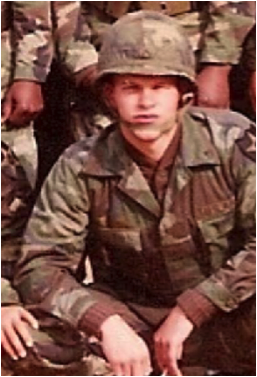
Note impact of Richard’s accident on me and presentation music: An avid Miles Davis fan, I obtained new albums as they issued. Siesta appeared in November 1987. Richard’s accident occurred 6 weeks later. I could not cope with Richard’s tragic circumstances then, so I abused drugs many times per week, and listened at full volume to the hauntingly beautiful music from Miles Davis and Marcus Miller. Now, 25 years in recovery from substances, I am empowered as I listen to Siesta. Often, I am tearful as my mind/body recalls those dark times, but I am renewed, and celebrate Richard’s life. As never before has this full presentation occurred, please forgive any confusion between competing volumes of the music and my voice.
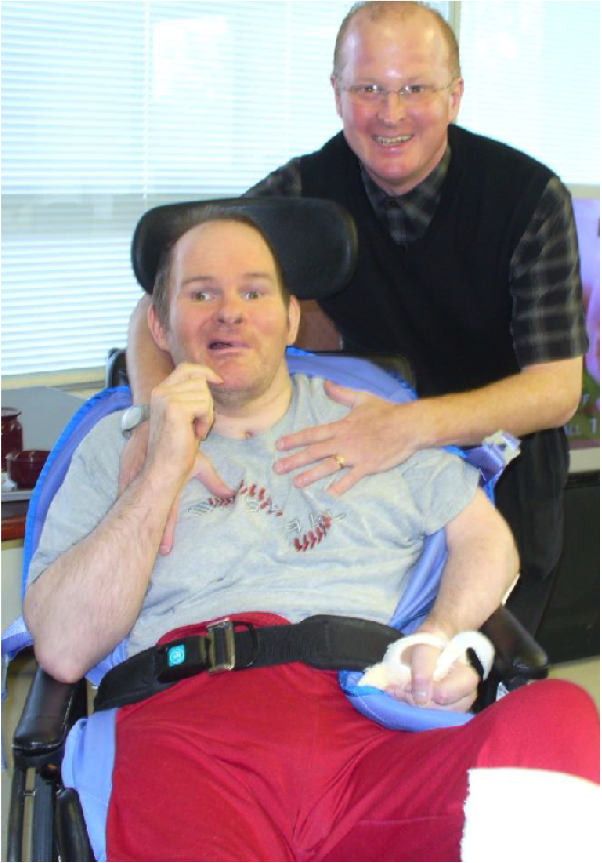
Richard is Lost
1987 ended with crime injury agony - catalyzed odysseys of pain
Heart-breaking anguished moments - continue ‘til this day
Severe traumatic brain injury - oxygen-deprived brain damage
Coma medically-induced coma - bored holes in his skull - relieved pressure
Multiple compound cracks/fractures - cranium rocked - how ever did Richard survive?
Extraordinary efforts to save him? - Yes, please do - with all speed skill haste
Savagely stolen childhood/lifelong friend - suddenly and forever grave
Happy New Year 1988
The following surged to paper nearly fully formed in less than two minutes. It was December 2008, I just returned from holiday shopping when an image of Richard alone in his wheelchair in his room came to mind. Never before had anything remotely like the urgent need to express sorrow/hurt/anger/frustration/loss/guilt occurred. The experience left me sad, shaking, terrified!
Gifts for Richard?
People, me included,
Scurry about achieving little
Except buying things
We could easily live without.
As if we are trying to
Put salve on a wound that is not there.
His concerns - more immediate.
View seldom changes only
Interrupted by sessions of pain caused by others
Who make a living on his inability
To do for himself what
Most of us take for granted.
To dress himself - impossible.
And, why should he attempt to cover what
His survival wrought?
He did not choose life like this, but was
Thrust upon him by people who could not
Bear the thought of life without him
What hell to bear witness to the
Collapse of another’s life!
Oh! The lives he could have lived!
Desolates the mind, breaks open the heart!
Torment to watch
Little relief to his life!
People, me included, distracted by trivia
Days flit past usually beginning with
“What will I do today?”
Personal trial yields this question:
Best gift of the day?
Make easier the paths for Richard!
A critical difference in the realities we confront stems from Richard’s inability to self-advocate. Consequently, he is unable to resist others, therefore vulnerable, his life subject to chance. Especially early during my recovery, I shared similar circumstances and experiences to Richard. My close connection with Richard leads to total acceptance, identification, and love. While Richard’s journey is a series of disabling events, my experience is largely one of impairment. In stark contrast to the abuse and neglect of Richard’s experience; my journey is one of recovering and enhancing physical, cognitive, psychological, and emotional abilities to meet demands/challenges from society.
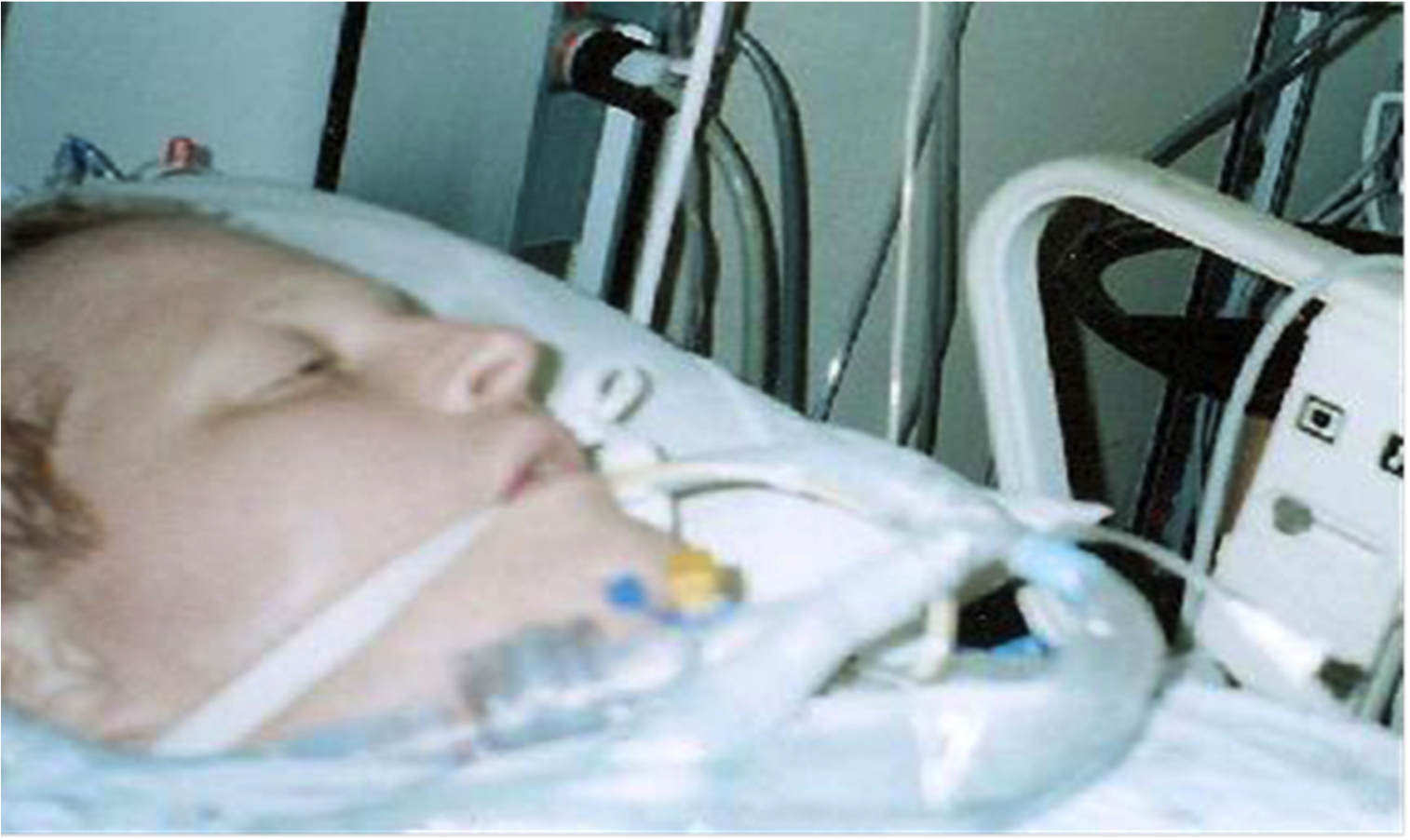
Now, pieces of my experience…
Hurtling mass
Crushes metal Shatters glass
Hips fracture Heart drains
Brain damage
Pain ascends Hope fades
Whelmed by wreckage
Sleep Not asleep Time sweeps past
Coma Amnesia Survival
Desperate cry Rends night
Crimson pain Sears sight
Cavern dark Absent light
Stony silence Burns bright
Blood pressure Falling slight
Compartments stretched Swellings affright
Brain compression New height
Infection clutches Grips tight
Amnesia enters Confusion fright
Blankets memory Shatters might
Severs confidence Enter blight
Emerging identity Fragile fight
Machines rescue Working right
Hope reverberates Survival tonight
Corners turned Hearts delight
Life certain Cognition alight
Like devastation precipitated by molten magma sliding
Through the oceans depths - compelling massive shifts to tectonic plates
Releasing tremendous energies that coalesce, rise, surface, form waves, speed away
Bring into being destructive tsunami
The tremendous concussive forces of the collision
Caused bloody brain damage/trauma/coma/amnesia - beleaguered cells
Time passed…cells eventually settle, reassemble, reorient, restructure, realign
Flicker back to life, disjointed identity reforms, cognition resumes, nascent self-returns
A few years ago, my friend Dr. Steven Singer helped me develop memoir. Parts of the next section I owe to him. Earlier this year, I presented in Malta to the Euro-Mediterranean Conference on Disability Studies and Disability Activism organised by the Department of Disability Studies, Faculty for Social Wellbeing, of the University of Malta. My presentation was so well received I was encouraged to submit to Encounters between Disability Studies and Critical Trauma Studies published by the Romanian journal Word and Text: A Journal of Literary Studies and Linguistics. This publication is now issued. The following developed through work with editors Dr. Arleen Ionescu of Shanghai Jiao Tong University and Dr. Anne-Marie Callus of the University of Malta. Great thanks to both for their many efforts!
Now, I ask simple questions and provide conceptual frameworks illustrating how massive forces of an automobile collision erased conventional understandings of my essence-identity and reduced me to a collection of cells struggling for survival in an indifferent, even hostile universe. First question, ‘what is reality?’ Answer: reality may be seen as matter/energy existing within the space-time continuum. Second question: ‘what is a human being?’ Answer: a human being can be regarded as a discrete mass of biological tissue – a matrix/factory where electrochemical exchanges, interchanges occur. Reality shapes/defines human beings as biological tissue, awash in nutrient molecules, interacts with external matter, energy, gravity. Most human beings from birth acquire abilities to process reality. Imagine however, processing reality; but at a slower rate; so much slower, society leaves you behind. For weeks, my body existed, but I was separate, outside of time.
2005’s longest day swept past, no awareness of self or time, detached – apart. Vague impressions of the outside world: sounds, voices, some comforting/familiar, brought the world closer, then receded. Who am I? What am I? When did this happen? Why was I held captive? In an agitated state, compelled to flee – ripped tubes from throat/body – left bed, only to hit the cold, antiseptic floor, hard. Subdued by staff – tears streaming – fought with every fibre of my being for release; until finally collapsing under the weight of strong hands, exhaustion, sedation; ensnared – entombed in my mind – enmeshed by a strait jacket, unable to escape, pinned to my bed. Few visible scars exist – others indelibly submerged. As memories surface, tears well in my eyes, splash down my face.
As the delicate electro-chemical structures of my brain experienced massive damage and disorientation, I existed for months without a sense of time. In the days following my attempt to leave, I complied with treatment. Later, as machines healed me, noises and terrible odours emanating from the devices summoned me to surface. For months, adult cognition failed. The operational fulcrum developed for decision-making became damaged, diminished – reverted. Slowly, steadily I re-engaged my surroundings, but with the cognitive/emotional abilities of a young child. I am informed, my childlike curiosity developed an insatiable hunger for audio/visual stimulation. I would spend hours in bed absorbing the sounds and images of children’s programming on a small television held so close that it touched my nose. Days passed…, friends read me children’s books. Others report, I would giggle and bounce my legs up and down in eager anticipation as pages turned. This stimulation helped me greatly as I first re-engaged the world.
Acquisition of spatial relationships, cognitive/psychological/emotional abilities gained in first days and years of life are small, incremental; individuals on neurotypical life trajectories experience a progression of days where knowledge gained from previous lessons is retained, enhanced, sharpened, and cemented. This usual development over time creates the neural pathways that become tools, or lenses with which we learn to recognize, process, and navigate our surroundings. We are equipped at the cellular level to identify and interpret the world we encounter. The brain, encased inside dense bone, receives input from eyes, and sensory organs to process and understand external environments. Most take for granted the time required to navigate disparate elements of reality successfully – to process – make sense of the mélange of ordinary and extraordinary environments in which we find ourselves immersed. I took for granted the neurotypical development I enjoyed prior to my accident; then the disconnection from time and self I experienced, mark the beginning of my new life. As coma/amnesia subsided, somehow, I filtered back through damaged brain tissues, enough neurons realigned, reactivated and I surfaced fully in late-July 2005. Without a clear understanding of what had occurred, disoriented, whelmed by emotion, overjoyed with simply being alive, I reunited with family/friends, then resumed life with my identity profoundly altered.
Brutally cold winter’s night, at home lying in bed, exhausted; caught a reflection in the mirror, but did not recognize the stranger. Who is he? Looks familiar, but… Suddenly, the sinking realization: face in the mirror was I. Time then dilated for many intense minutes, body convulsed, mind collapsed, tears fell. Like falling from a great height, I shattered on the cold, hard ground of pitiless reality. The episode left me breathless.
My mental/physical decomposition that night was hardly surprising. Only eight months passed since 4:34 pm, Tuesday, May 17, 2005, when I initiated a call, then failed to yield to a 3,000 kilogram SUV travelling 80 kph and it smashed into me.
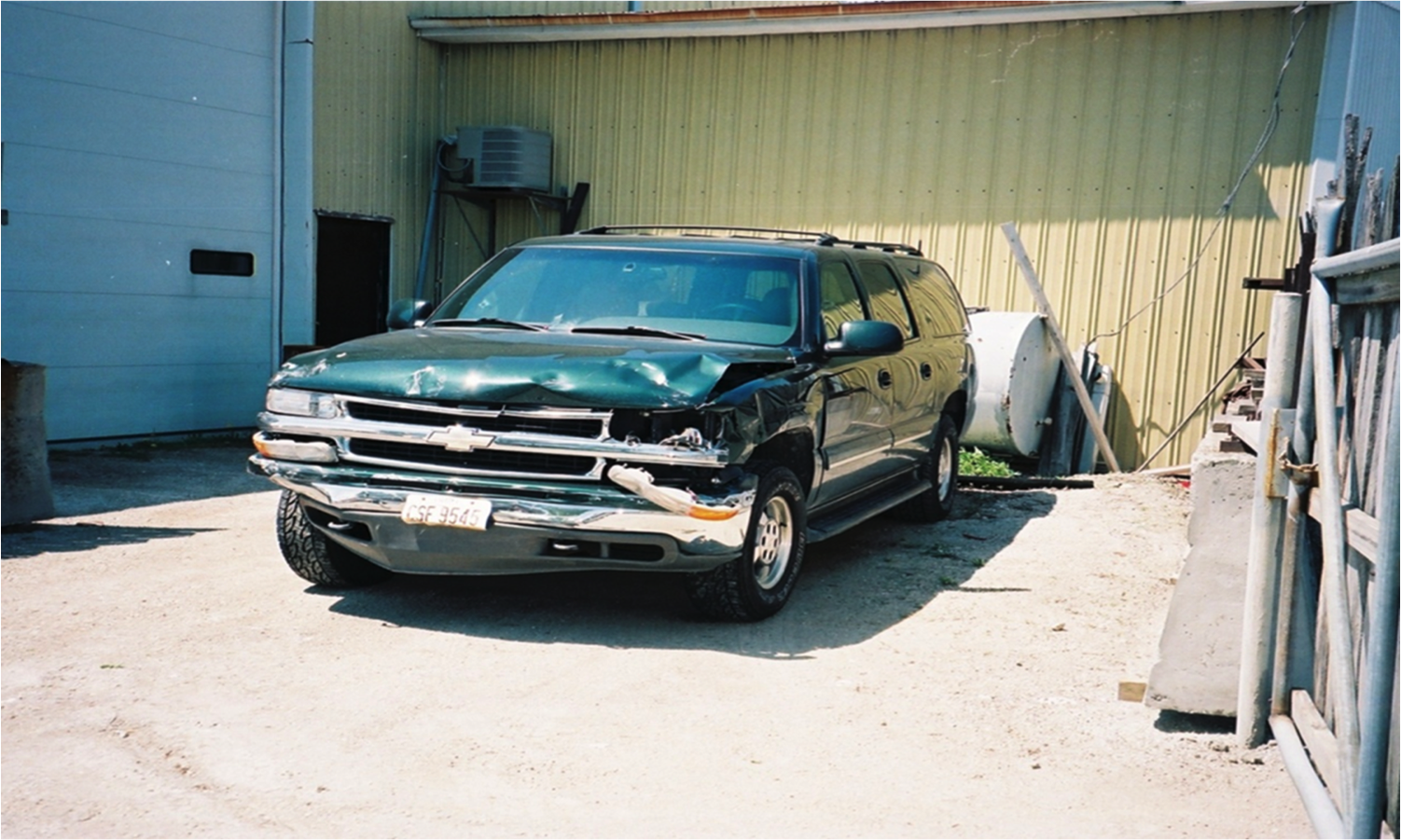 |
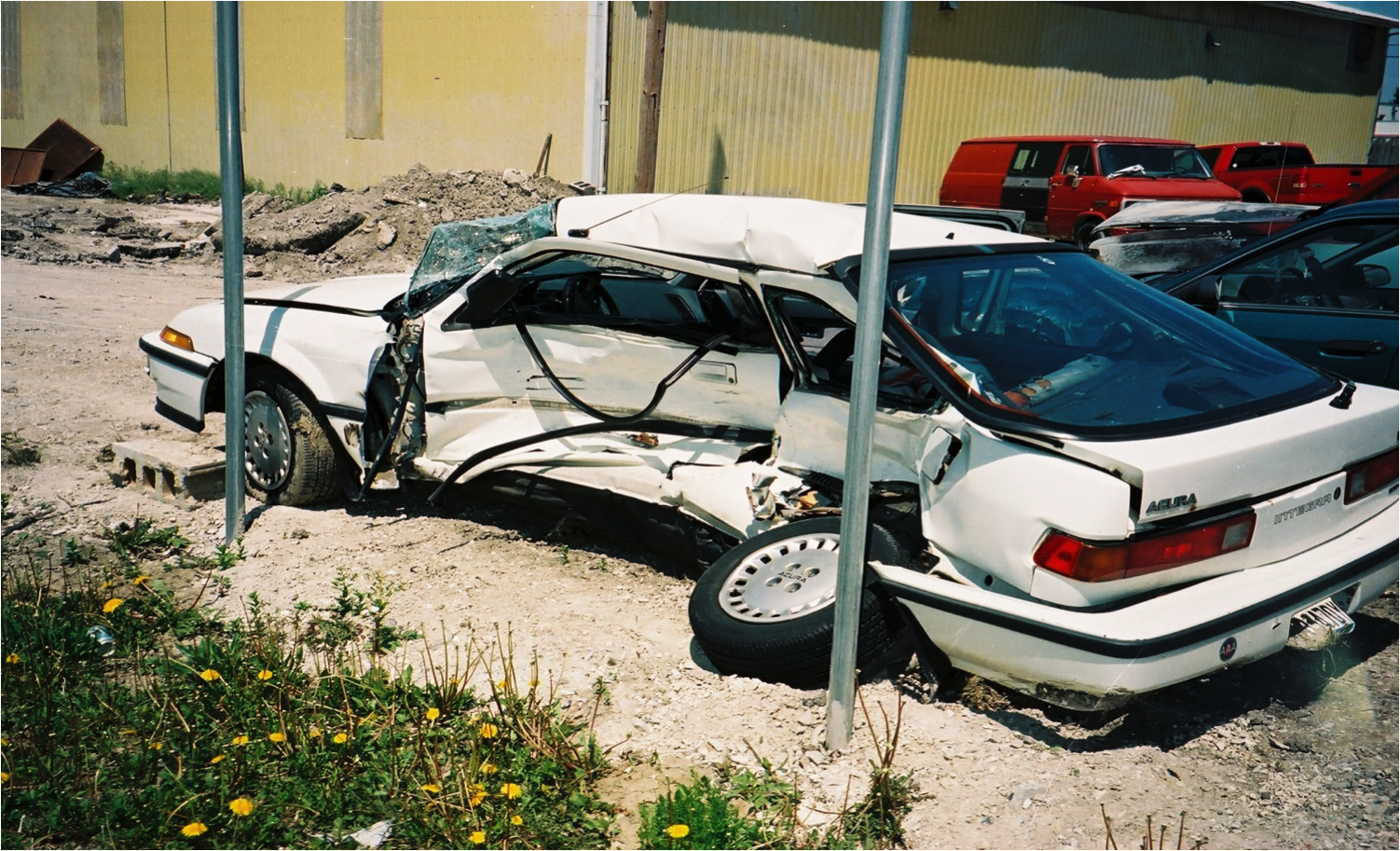 |
The image on the right shows Douglas Kidd’s two-door white car with its mid-section damaged by the SUV. The driver’s side rear wheel is twisted and is nearly parallel with the ground.

Catastrophic injuries: severe traumatic brain injury with haemorrhaging led to coma/amnesia of 75 days; massive internal bleeding from lacerations to rectum, liver, spleen, abdomen; compartment syndrome injury to right leg; multiple hip fractures; cardiac arrests; respiratory failure; MRSA. I was discharged, September 15, 2005. Instead of daily workouts in hospital, I underwent 3 sessions per week of outpatient physical, occupational, and speech therapy. By October 2005, I resumed my work as an industrial designer. In January 2006, eight months after the accident, returned to university. All pressures combined to produce the episode. Like using a treadmill that suddenly spins too fast, I fell. Exhausted, brain ceased to process, overwhelmed by fear, shutdown, shuddered. Time sped by so fast – too fast – I could not breathe. I felt like I plummeted towards a bottomless pit looking to swallow me whole; hoped if enough fell, the pool of tears would break my fall; then gently I would float to the surface safe, whole, alive. Twelve and a half years removed as of this writing, searing remembrances of my first temporal dissonance remain. As memories surface, tears well in my eyes, splash down my face.
Now, a few more pieces of me…
Wandering through wintery wastes trying to find purchase
Attempting the cold stone slippery steps cut by nondisabled minds
Slipping here falling there perseverating on the flecks of fool’s gold?
No wounds cut so deep as those ministered by the capacitated on the incapacitated
And, why do cognitively disenfranchised undeservedly inherit such animus?
No reason/rhyme - ‘cept lack of power to meet whelming tides of speed/contempt/disregard
Nondisabled leader’s threat: “If you repeat this, I will deny it…they do nothing all day”
Cognitively nondisabled’s prerogative (whim) sets tone/pace - exclude
Observant eyes listening ears feeling bodies caring hearts
Othered minds - see hear feel - offer a way through
The following is a brief description of the genesis for my next poem entitled, Ableism’s Anvil - The Treadmill. Over the decades, a great admirer of Charles Dickens’ many achievements, each holiday season I read from A Christmas Carol. Ebenezer Scrooge suggests disadvantaged people apply to workhouses for assistance when he was asked to make a donation for the poor. Scrooge asks the men soliciting provisions for the poor if the prisons, workhouses, or treadmills remain in operation. The men stated sadly these state institutions were in operation. Scrooge stated taxes he paid supported the workhouses and directed the men to seek assistance for deprived people elsewhere. Upon reflection, the treadmill seems an apt analogy for ideas regarding arbitrary and questionable standards of production, as well as the implications for disabled people in society.
Caught (splayed out) by ideals of arbitrary standards of production
Hypothetically conjectured quotas to maintain and so remain
Felonies against human dignity - and thus divinity is lost
By oppressors need for efficiency - no thought given to cost
Effects of insatiable greed - cruelty and pain - simmer as in a tempest tossed
Best practice for humanity sacrificed on the alter of throughput
Those considered defective - discredited - disabled - helpless - relegated without thought
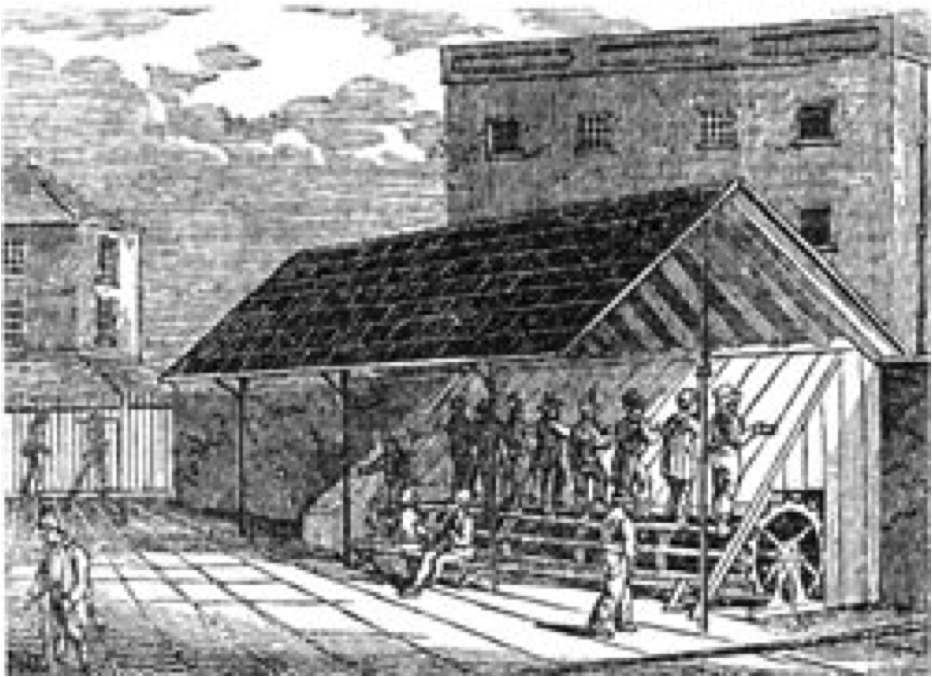
This image shows an illustration of a large cylinder about 4 feet in diameter and 40 feet long with wooden planks attached which were used as steps to revolve the device. There are eight human beings evenly spaced along its length.
Invented in 1818, the nasty device consisted of a metal cylinder with steps built on it so far apart that one had to step way up to catch the next one before the cylinder revolved around under one's feet, rather like a wheel in a hamster cage. Convicts were required to walk on the treadmill six hours at a time. https://www.geriwalton.com/the-treadmill-for-punishmen/
Next, this poem attempts description of the aftermath of trauma, disorientation and disconnection; yet slowly turns to recovery, reclamation of self and identity, and re-assimilation with others.
Centered in The maze I turn
Only to find No way through
Or out bereft of Cognition I spin
Faster - until Smothered by the high
Walls of Achievement that lean
In - cowed by the Temples of know
Forced to (re)build My collapsed mind
Making difficult the Ability to grow
Up & out - Caught - splayed - locked
In by enveloping Coma consuming
All - terrified by People - profound
Uncertainty with the Scope - pacing
Of society - life - Searching for ground
To stabilize - within - Chaotic sowing
And managing of Confusion - weakened
In the midst of the Higher level processing
Required to maintain even a tenuous
Grip - grasp - fragile hold - on reality
Which (re)forms Identity & encourages
Nascent self To (re)Join humanity
The Well
How far down did you go?
Fathomed depths Few have been.
How long were you gone?
Soo much time Never the same.
What did you come to know?
Coma dark fear Hurt isolation strain.
How long were you gone?
So many days Left behind my name.
Why attempt to return home?
Ask salmon Why they spawn.
Whence comes the spirit to grow?
Hawking argues Law of gravity alone.
What marks Sears to the bone?
Upward journey Unconquered pain.
Where discover/fix joy?
Places tender Meek being.
Why compelled Produce tome?
To find/order Mind/self Sane.
What gives You hope?
Community sharing Kindness humane.
Why move out From well’s shadow?
To reclaim all Before last lights wane.
Last poem,
From death coma/amnesia straight jacketed by walls of damaged brain tissue to life/rebirth
Hearing thinking touching feeling verbalizing remembering trying organizing standing walking
Driven to relive (replay) events so they turn out differently compel fear & frustration
Grieving quietly (passing) turn to identification/acceptance/belonging
Renewed, refreshed, driven to express, find community, roads to
Oświęcim Paris Berlin Vienna Palantino Sliema Montréal
In closing: human beings emerge from and exist within reality. Personal experience illustrates how sensitive the mind/body are as processing tools of reality. Envision the gelatine-like brain defined, ordered, separated by dense bone into compartments of knowing. Consider this working system suddenly, violently shaken so hard, brain damage ensues and total negation of self occurs. For a while, loss dominates. Time passes… Slowly brain tissues heal, reconstitute, reassemble, restructure at the cellular level. Cognition flickers, self steals back, reclaiming the void. Now, examine one restored human being processing reality in space/time, but with a tendency to slip/disorient; yet throughout recovery possesses a great desire to realize identity, uncover meaning, discover belonging, find community, and celebrate.
As I daily embrace outcomes of our catastrophic accidents, I hold memories of the Richard I once knew close in my mind. The aftermath of accident, trauma, coma/amnesia, and resultant impairments, along with bonds of identity forged through common experience created the closest connection, deepest admiration, appreciation for Richard and the wondrous experience of simply being alive. I treasure Richard’s life and look forward to our futures with hope. Peace and thank you very much for your time.
Glossary of Terms
Advocacy: the act or process of supporting a cause or proposal
Auto-ethnographical: a method or form of social research that serves the purpose of exploring personal experiences of the researcher
Decompensate: functional deterioration of a previously working structure or system
Detrimental: obviously harmful
Dissonance: lack of agreement
Neurodivergent: sometimes abbreviated as ND, means having a brain that functions in ways that diverge significantly from the dominant societal standards of “normal.”
Neurotypical: often abbreviated as NT, means having a style of neurocognitive functioning that falls within the dominant societal standards of “normal.”
Severe Traumatic Brain Injury (TBI): commonly described as a loss of consciousness or coma lasting more than 24 hours, post-traumatic amnesia of more than 24 hours, or abnormal brain imaging results. Source: http://www.northeastern.edu/nutraumaticbraininjury/what-is-tbi/severity-of-tbi/
Temporal: of or relating to time as opposed to eternity
Vocation: the work in which a person is employed
Bio:
Douglas, in his 17th year of recovery from severe traumatic brain injury has poetry, essays, and articles published; presented to international audiences from Honolulu to San Francisco to Chicago to Bergen, Norway to Amsterdam, Nederlands to Sliema, Malta to Montréal, Québec, to Debrecen, Hungary; leads a brain injury support group; his safe-driving advocacy non-profit is affiliated with the National Safety Council in Itasca, Illinois; he improves the community as member of Disability Rights Ohio; and performs social work for the largest mental healthcare provider in Northwest Ohio.